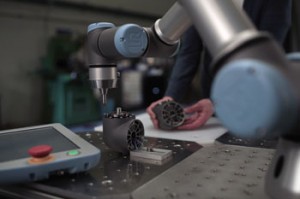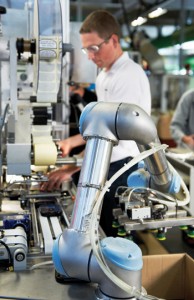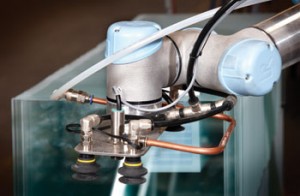Choosing the right robot – Applied Automation
 The experts at control specialist Applied Automation review the ever expanding robot market and how to make the right choice for your application.
The experts at control specialist Applied Automation review the ever expanding robot market and how to make the right choice for your application.
Demands on production lines and robot cells are continuously increasing. This involves factors such as quality and flexibility, as well as energy efficiency, sustainability and productivity. Additional operations usually require additional robots; but with the facility to quickly and automatically change the tools on a robot arm, the need for a second or even third robot is eliminated, significantly reducing the capital investment required, improving payback and often reducing the overall cell footprint.
For years, the robot market was fairly static in terms of new products; then along came the collaborative robots. These ‘cobots’ have stimulated the next phase of development in robotics and are driving growth in the sector. The range of robot types has become broader and, arguably, the selection of a suitable robot for an application has become more complex.
There are six primary types of industrial robots: articulated – the unit is fitted with rotary joints; cartesian or gantry – the robot is constructed from linear axes; cylindrical – the robot has one rotary joint at the base and one prismatic joint; polar or spherical – the arm is connected to the base with a twisting joint and a combination of two rotary joints and one linear joint; SCARA – the robot is similar to a cylindrical type but has two parallel joints that provide compliance in one selected plane; and delta – where the robot is spider like with three or four arms or parallelograms connected to a common base. There are a number of variants of each type subject to the number of axes fitted or required, or where the robot design has been tailored to suit a specific process.
Confused? You have every right to be. The choice seems complicated. However, you can simplify the selection process by first considering these seven points:
1. The process
There are robots available in the market that have been specifically designed to suit certain applications: welding robots, paint spraying robots or palletising robots. In this instance, you can be confident that the robot type is suited to the application.
2. Mass of the product
Consider the mass of the product or products to be handled and add to that mass the allowance for the end effector which is generally some form of gripper unit. Also allow for any process loads, ie if the robot is going to be used to press fit a component into another, you need to add on the insertion force. Obviously this is one of the most important factors – small robots typically have a load carrying capacity of 2 or 3kg but some of the big articulated handling robots can carry loads of 2000kg or more.
3. Field of operation
Determine the field or zone within which the robot needs to operate – the robot reach. Subject to the robot type, the shape of the operating field changes. A Cartesian robot constructed from three linear axes – two horizontal and one vertical – and can operate in a simple box or cube shaped zone, whereas a SCARA operates in a heart or kidney shaped prism with a circular hole passing through the middle. Some robots can be mounted inverted, and it is quite common to see an articulated robot suspended from the ceiling in order to gain the best use of its working envelope.
4. Dexterity
Decide on the dexterity required: for example, does the robot only need to operate in two planes for a pick-and-place operation or are the movements required much more complex?
5. Accuracy
What accuracy/repeatability is required at the end effector? If you need to pick up a part and insert it into a tight tolerance hole, the robot needs to provide sufficient accuracy for the fit to be achieved. The most accurate robots will quote repeatability figures of ±0.01mm whereas for something like a spraying operation you can use a robot with far less precision.
6. Speed
Determine the speed of the operation or cycle time and be aware of the likely path of movement or any objects within the field of the robot which it may need to avoid.
7. Environment
What is the nature of the environment within which the robot will operate? There are robots designed specifically for clean room applications where the robot must not shed debris and other robots designed to work in ATEX rated environments.
Based on these considerations, we can now explore the different types of robot available.
 Articulated robots. Typically a 5- or 6-axis robot, the articulated robot is the most dextrous. They are frequently used for handling or assembly work, spray painting, spot welding, arc welding and machine loading. Articulated robots are available with load carrying capabilities from a couple of kilograms to more than 2000kg and have a reach of up to 4m. They can be very accurate/repeatable and pretty fast, particularly where a lighter load is carried.
Articulated robots. Typically a 5- or 6-axis robot, the articulated robot is the most dextrous. They are frequently used for handling or assembly work, spray painting, spot welding, arc welding and machine loading. Articulated robots are available with load carrying capabilities from a couple of kilograms to more than 2000kg and have a reach of up to 4m. They can be very accurate/repeatable and pretty fast, particularly where a lighter load is carried.
SCARA robots. Commonly used for assembly applications or high speed handling of parts, the SCARA robots tend to be quicker than articulated robots but are less dextrous and generally are not able to provide a great reach or the ability to handle large masses.
Cartesian or gantry robots. These are a relatively simple robot usually offering 2 or 3 axes of movement in a simple straight line format. They are generally used for simple pick-and-place applications, palletising or perhaps the unloading of a mould machine. A small scale Cartesian can be relatively low cost and simple to integrate and program, whereas a large scale Cartesian can be designed to take extremely high loads and have very long axis of travel. Cartesian robots tend not to be used for very high speed applications.
Delta robots. Delta are the highest speed robots available in the market with the ability to operate at 10m/s and undertake a standard reciprocal goal post move of 25mm lift, 305mm travel and 25mm lower with a mass of 1kg in 0.36 seconds. Generally though, this robot type is not able to carry very high loads (up to a maximum of 6kg) so they tend to be used for high speed pick-and-place applications, perhaps picking parts from a moving conveyor and placing them into a container.
 Collaborative robots. The new kids on the block, collaborative robots can work alongside employees without the need for guarding. They are the real game changer. In effect, they are an articulated arm type robot but can safely limit the force generated and set safety limits on their fields of movement. The Universal Robots cobots are easy to program, have a relatively low purchase price and are very easy to deploy, hence a rapid ROI.
Collaborative robots. The new kids on the block, collaborative robots can work alongside employees without the need for guarding. They are the real game changer. In effect, they are an articulated arm type robot but can safely limit the force generated and set safety limits on their fields of movement. The Universal Robots cobots are easy to program, have a relatively low purchase price and are very easy to deploy, hence a rapid ROI.
With these general types of robot (and their variants), the choice really comes down to your application. We hear that 30% of the collaborative robots sold are being used in applications where a traditional articulated robot would operate. That means a staggering 70% are being used in new applications, so cobots really have opened up a wide variety of industries. They have many advantages. However, cobots tend not to carry high payloads or operate at very high speeds. Switching from traditional to collaborative robots is not a straightforward swap.
So what is the best type of robot? The simple answer is that it completely depends on your application. It is an exciting time for the industry, with collaborative robots driving innovation and providing new opportunities. With new developments there are now so many options available you have a far better chance of finding something to suit your specific needs.
Visit the Applied Automation website for more information.
See all stories for Applied Automation















